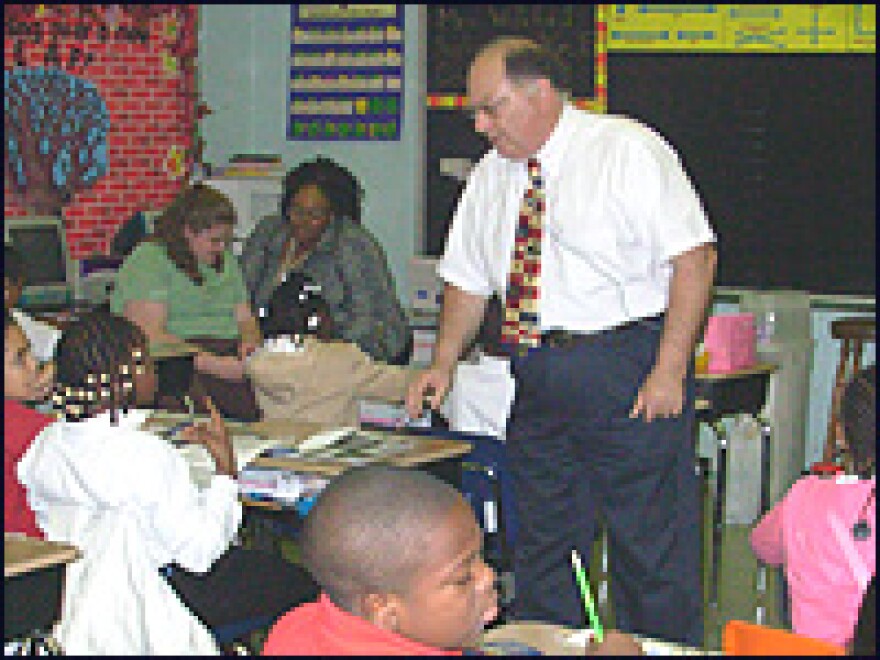
A year ago, the playground at Gompers Elementary in Philadelphia was nothing but a slab of asphalt. No swings, no slides, no monkey bars.
But last spring, all that changed.
Joe Cifelli, a professor of education at nearby St. Joseph's University, and his colleagues decided to build a playground. The educators had received a $700,000 grant from the Centers for Disease Control and Prevention to put forth a program to fight obesity. The playground was just one of many projects covered under the grant.
Cifelli also started teaching nutrition in the classroom. Once a week, he turns a fourth-grade classroom into a science lab. And he uses techniques that won't bore kids to tears or make them feel guilty about their favorite foods.
"How many people like cheese curls?" Cifelli asks the class of 9-year-olds. When every hand shoots up into the air, he opens up a bag and asks them how many they'd like to eat.
"Three," says one child.
"The whole bag!" says another.
The point of bringing cheese curls into the classroom, Cifelli explains, is to figure out whether they have energy.
The lesson Cifelli aims to teach is that food is the equivalent of energy. And calories are simply a unit of measurement for the energy. These concepts are new to the students.
"How many of you think cheese curls have energy?" he probes. About half the kids raise their hands.
"OK, half of you say yes and half say no. Good," Cifelli says.
Cifelli knows that if he just blurts out the answer, the kids will lose interest. He wants them to figure it out. In order to bring the lesson alive, he sets the cheese curl on fire.
"I'm just going to put this flame under it," Cifelli tells students, "and we're going to watch what happens." A beaker of water sits over the burning cheese curl, and Cifelli uses a thermometer to measure the temperature.
As the flame grows, Cifelli asks them to describe what they see. They talk among themselves about the smoke and the flame, then Cifelli shows them that the curl is burning on its own. He's no longer lighting it with a flame from below.
"What does this tell us?" Cifelli asks.
"It shows us that the cheese curl has energy," answers a student.
In order to figure out how much energy, Cifelli dips the thermometer in the beaker of water and takes a second reading.
"When we look at the new temperature, we can see that it's 45 degrees Celsius. We can see it's changed," says Cifelli. He asks them to use their calculators to compute the change. He explains that the difference between the old temperature and the new temperature is the key to calculating calories.
Cifelli doesn't expect the student to walk away with the precise understanding that a calorie is the energy needed to increase the temperature of 1 gram of water by 1 degree Celsius. Rather, he wants them to grasp a broader understanding. When he asks for questions, student Tiantia Willis says she know cheese curls are junk food, so she was surprised to see they have so much energy.
"When I saw all that energy and fire, I was thinking maybe that is good for you," says Willis.
This point leads to Cifelli's next lesson, which will focus on what kinds of energy are good for the body.
"I firmly believe in the notion that learning is mostly talking, and teaching is mostly listening," Cifelli says. "So the idea is that we can get these kids to talk to each other about this stuff. They're actually using words like calories and energy and saturated fats."
Cifelli's hope is that the knowledge empowers students to make healthy choices. But he knows this won't happen overnight. He learned this last year when he invited a few students who'd just finished his course to join him for lunch at St. Joseph's cafeteria.
"They just filled up their plates with everything they could. They had big fries and hamburgers. One girl said she was watching what she was eating, so she just took one hamburger instead of two," Cifelli says with a laugh.
Cifelli says he takes comfort in seeing that kids are spending lots of time on the new playground -- exercising.
Copyright 2023 NPR. To see more, visit https://www.npr.org. 9(MDM3NjYwMjA5MDE1MjA1MzQ1NDk1N2ZmZQ004))


